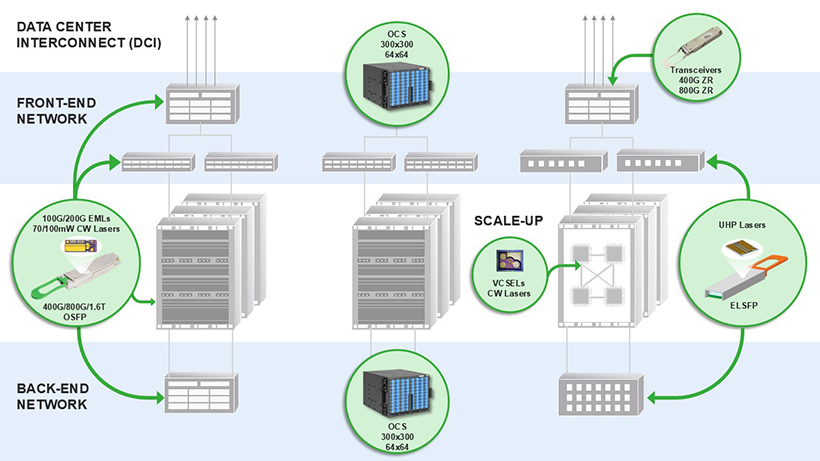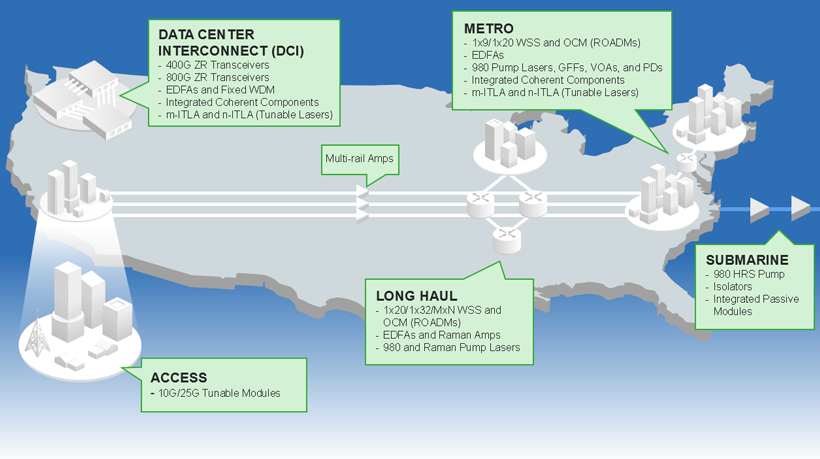Transmit. Receive. Amplify. Switch.
08/13/2025
Lumentum is a company that is built on 40+ years of heritage as a pioneer and ground breaker in optics and photonics. At the root of this heritage has always been our products. We focus on reliability, and we focus on performance.
The network diagrams below help to provide an overview of where the key Lumentum Cloud and Networking products are typically deployed in an AI/data center or telecommunications network. The Lumentum products underpinning these applications can be organized into four primary photonics functions. Here, we elaborate on how those industry-leading products allow for a world of high speed, interconnected optics that transmit, receive, amplify, and switch.

AI and Data Center Network
Transmit
All optical communications are initiated by devices that send or transmit data. These are composed of lasers and modulators, and sometimes these functions are combined into a single chip.
- Electro-absorption modulated lasers (EMLs)
EMLs integrate a diode laser and an electro-absorption modulator onto a single chip, which results in efficient modulation of the laser’s light output and makes it suitable for high-speed (up to 400G and above) data transmission.
- Silicon photonics modulators
Built on a similar CMOS process to traditional electronic components, silicon photonics modulators enable high levels of integration and are driving the recent industry advances in co-packaged and near-packaged optics.
- Continuous wave (CW) lasers
CW lasers are built using indium phosphide (InP) processes and generate high-power unmodulated light. They are primarily used as a light source to power silicon photonics modulators. Lumentum also offers our industry leading ultra-high power (UHP) laser in this category based on our high-reliability pump laser that is capable of providing over 400 mW of power.
- Coherent modulators
Lumentum builds a range of coherent modulators based on our high-speed, low-drive voltage InP platform.
- Tunable lasers
Tunable lasers are used as CW light sources for DWDM applications in metro and long-haul networks. They are capable of tuning across a wide range of wavelengths. Lumentum’s tunable lasers lead the industry in performance and shipments, based on our external cavity laser (ECL) technology.
- Vertical cavity surface emitting lasers (VCSELs) and directly modulated distributed-feedback lasers (DFBs)
VCSELs are the lowest cost, lowest power consumption lasers for communications, however, they are only suitable for short reaches (up to 100 m). Directly modulated DFBs operate in a compact and economical footprint for lower data rates.
Receive
Lumentum develops photodiodes for a host of different applications, including high-speed photodiodes for data center and telecommunications applications and for tap/monitor applications.
Lumentum’s transceivers include transmitters and receivers in line with the transmit and receive technologies above.

Telecommunications Network
Amplify
Amplification is at the heart of every telecom network. We have an extremely broad-based selection of amplifiers from 980 nm pumps to Raman amplification (which enhances the strength of optical signals via the stimulated Raman scattering effect within an optical fiber) to submarine pumps, and even amplifiers that are used in satellite applications. Here, reliability is key, as a single amplifier is typically loaded with tens of Terabits of traffic, and nowhere is reliability more critical than in the submarine part of the network where Lumentum is a clear market leader.
Lumentum also has semiconductor optical amplifier (SOA) technology. These mini amplifiers are built in InP and can be integrated with our chips, including lasers and SiPho chips, and are increasingly believed to be essential elements of next-generation transmitters and receivers.
Switch
We have multiple products that switch, including:
- Wavelength selective switch (WSS) products that switch individual wavelengths at nodes in metro-area and long-haul networks. These are built on decades of knowledge in micro-electro-mechanical systems (MEMS) and liquid crystal on silicon (LCoS) based technologies. WSS technology has a long history (debuting in the early 2000s), and our MEMS technology proved vital in its development. WSS acts as a flexible and programmable switch in ROADMs by dynamically routing different wavelength channels to various output ports without the latency created by electrical processing.
- The optical circuit switch (OCS) is an exciting new product for us. Targeting data center applications, our OCS is built on a single-crystal silicon MEMS design that has been proven in the field with hundreds of millions of operational cycles and in more than 150,000 WSSs deployed to date in telecom networks. The OCS can eliminate an entire layer of switching in the data center, with significant reductions in power consumption and cost, while simplifying the upgrade cycle for future speeds. It is wavelength agnostic, bit-rate transparent, and provides very low insertion loss.
We hope you enjoyed this inaugural post of our company blog and that this overview has inspired you to learn more about our “transmit, receive, amplify, and switch” portfolio. For more details, please visit the Products page of our website.

